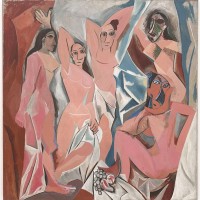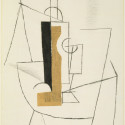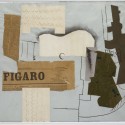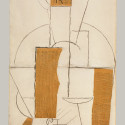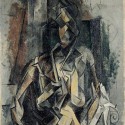Listen to The Afro-Cubist *
* Audio renditions use sounds from Sibelius Sound Essentials and therefore may not fully represent the intention of the music or the intended final outcome.
The Afro-Cubist is a different kind of indoor percussion piece.
Inspired by the Cubist works of Pablo Picasso, which in turn was inspired by traditional African art, the music presented in The Afro-Cubist ranges from traditional African percussion music to South African a cappella to African pop music. Picasso began his foray into Cubism with the painting Les Demoiselles d’Avignon (1907), and as the music transitions into other styles and periods of African music, other subsequent paintings serve as the visual backdrop: Woman Sitting In A Chair (1910), Bottle And Wine Glass On A Table (1912), Man With Hat And Violin (1912), and Bottle Of Vieux Marc, Glass, Guitar And Newspaper (1913) were but some of the paintings viewed before writing of the music began.
This show was also inspired by Afro-fusion musicians as well as more traditional musicians; this show was influenced by the works of such artists as, amongst others, Babatunde Olatunji, Ladysmith Black Mambazo, Femi Kuti, and even such musicians as Paul Simon, the unofficial American ambassador of African music, and Mickey Hart, ambassador of world/ethnic percussion. As Picasso’s Cubist works are essentially an evolving hybrid of his own ideas and aesthetics, the last two artists were fitting influences. Other traditional music was studied as the piece tried to retain as much natively African influence as possible.
What makes this show unique is that it isn’t full of traditional battery parts, mallet runs, flashy features, etc. Many phrases are looped and much of the auxiliary percussion parts, which are designed to make use of the typical drumline’s arsenal of equipment, are multi-layered cacophonies of sound that, when played together, create a rich texture that attempts to create density and space at once. The mallet-percussion provides brightness and melody, trying to evoke the sensibilities of African vocals and pitched percussion. The battery parts play off the auxiliary rhythms inside of rudimental patterns, loops, and textures.
There’s a even a step dance for the battery during the South African a cappella-inspired portion of the music, where the sounds of the footsteps are important to everything that’s going on around them.
This is a fun, groovy piece that is deceptively simple and deceptively difficult at once. It’s a different kind of challenge for your indoor drumline and it’s sure to be both an ensemble and audience favorite.

